Orient Express
![]()
This article explains the railway connections of this name. For other meanings, see Orient Express (disambiguation).
The Orient Express was originally a luxury train of the Compagnie Internationale des Wagons-Lits (CIWL) consisting only of sleeping and dining cars, which first ran from Paris to Constantinople (since 1930 Istanbul) on 5 June 1883. As the destination could not yet be reached continuously by rail, ferry and ship connections had to be used at first. From 1890 onwards, there was a continuous connection via southern Germany, Vienna, Budapest and Sofia to Constantinople. The train, often referred to as the King of Trains and the Train of Kings, was the core element of an entire system of luxury trains that served primarily to connect Paris and the Channel ports with various destinations on the Mediterranean and in Central and Southeastern Europe.
After World War I, the Orient Express ran to Bucharest, and the connection between Paris and Istanbul was taken over by the Simplon-Orient-Express via Milan, Venice and Belgrade, which was often also called the Orient Express. After World War II, the luxury train genre was abolished in 1950 and the trains were converted into regular express trains, which retained the Orient designation in their names. The last through service between Paris and Istanbul was the Direct-Orient, which was discontinued in 1977. The train run named Orient-Express ran only as far as Vienna from 2002 and started in Strasbourg instead of Paris from June 2007 until it was discontinued altogether in December 2009.
Since the 1970s, various operators have offered special and tourist trains with restored old carriages of the CIWL, which derive their names from the historic Orient Express. The Orient Express has also become famous as a setting in film and literary classics, especially Agatha Christie's crime novel Murder on the Orient Express.

Train running sign in the railway museum Bochum-Dahlhausen
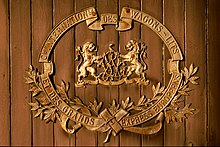
CIWL coat of arms on the teakwood WR 402 in the former railway museum Kerzers/Kallnach

Historical advertising poster of the Orient-Express from 1888
Vehicles
The Orient Express quickly became popular, especially because of its sleeping and dining cars and the comfort they offered, although the actual comfort offered did not always match the reputation and legend that the luxury train had soon acquired. The railway companies involved each used their most modern express locomotives, although freight locomotives were also used in wartime and post-war periods.
Car
The CIWL had ordered new cars for the introduction of the Orient Express in 1883, but they had not yet been delivered at the start of operation. From June 1883, the company therefore still used mainly three-axle sleeping and dining cars. It was not until the autumn of the same year that the new cars with bogies supplied by Rathgeber in Munich were able to take over operation. Initially, the CIWL had individual vehicle series developed for each of its luxury trains. These were partly supplied by various European wagon construction companies, partly built in CIWL's own workshops. From about 1910 onwards, the vehicle fleet was standardised and large series of a few vehicle types were built. Until 1922, however, the wagons were still used in fixed rotations in each case; only after that were they generally no longer used specifically for certain trains. While the sleeping and dining cars were all four- and six-axle bogie cars from the fall of 1883, the CIWL still used two- or three-axle baggage cars on the Orient Express until shortly before the First World War.
Just four years after the introduction of the train, the CIWL put a new series of cars into service for the Orient Express in 1887, and the cars used also changed frequently in the years to come. After 1890, the CIWL, like most Central European railway administrations, gradually introduced carriages with bellows, which provided a protected and safe passage between carriages. Until then, the wagons had still had open boarding platforms.
As a rule, the Orient Express and the other luxury trains of the Orient Express system consisted only of sleeping, dining and baggage cars. Saloon and Pullman cars were used by the CIWL only occasionally on partial routes; their use was otherwise limited to the Pullman Express trains established since 1925. Most attempts of this type, for example on the scenic routes of the Arlberg-Orient-Express, proved unprofitable. The last attempt was in 1949 with a Pullman car on the Basel-Vienna section. Normal seating cars of the railway companies over whose lines the trains rolled were not used until after the Second World War. The sleeping and dining cars remained in the possession of the CIWL until 1971, after which they were transferred to the TEN pool of the state railways, the CIWL only taking over the management.
From the mid-1880s until 1922, the CIWL procured all of the cars with the characteristic teak exterior panelling, only some of the saloon and Pullman cars not used on the Orient Express had the window area painted cream. The last series of sleeping cars of this design were designated Type R, and in some cases older cars were converted to this type. All of the cars had wooden superstructures.
Starting in 1922, the CIWL procured only sleeping cars with steel bodies, whose new color scheme in dark blue with gold lettering soon became typical for the entire CIWL fleet. From 1926, corresponding dining cars were also supplied. However, the company did not discontinue the last teakwood cars until after World War II, after they were only used in subordinate services.
The first series of blue all-steel cars was designated as type S and was procured for the luxury train from Calais or Paris to the French Riviera, later called Train Bleu according to the color. The Orient Express and the Simplon-Orient Express received the blue cars starting in 1926. Various series of the type S were procured, the cars had four two-bed and eight one-bed compartments. With the Great Depression, the CIWL had to introduce second class on its luxury trains to remain profitable. This meant that from 1930 onwards, the type Z and Y coaches, which were fully equipped with two-bed compartments, were also used. In contrast, the type Lx, known for its use in the Train Bleu and the various tourist trains such as the Nostalgia Istanbul Orient Express and the Venice Simplon Orient Express, with its particularly luxurious equipment, was not regularly used in the Orient Express system before World War II. Only on some sections of the Simplon-Orient-Express or the Orient-Express did type Lx or the substructure types Lx10, Lx16 and Lx20 run. For this the Simplon-Orient-Express received a baggage car with a shower compartment as a special feature starting in 1930.
After 1945, old type R teakwood cars were still used for a time on the Simplon-Orient-Express, but were soon withdrawn from service on this train run. The type S remained in service until 1965, most recently between Paris and Bucharest. The Lx coaches, originally carrying only single-bed compartments, were soon fully or partially converted to two-bed compartments and also ran on the Orient Express system trains after the war. By the end of the 1960s, they were also replaced by newer cars, as were the types Z and Y. From 1955, the first new type P sleeping cars came into use. The CIWL built these under license from the American vehicle manufacturer Budd with stainless steel exterior walls. The type MU cars procured in 1964 were also used on the Orient Express.
Since about the mid-1960s, the remaining train runs and cars of the Orient Express system no longer differed significantly from other international long-distance trains in Europe. From 1968, CIWL introduced the uniform type T2, which DSG also used and which was further procured by the participating state railways from 1971 in the course of the TEN pool. Since the 1950s, the trains also had couchette cars, which were provided by the participating state railways.
The pre-war blue steel dining cars remained on some sections of the Orient Express system until 1966, but in principle the CIWL used newly supplied dining cars from 1950 until the use of dining cars gradually ended from 1962. On the Eastern and Southeastern European lines, the use of CIWL dining cars ended as early as 1950, with the exception of the Greek and Turkish lines, but the state railroads there continued to use older dining cars taken over from CIWL for years.
Until the Orient-Express was finally discontinued in 2009, its rolling stock still consisted of seating, sleeping and couchette cars from the state railways involved.
Locomotives
About 20 different locomotives were used on the first run of the Orient Express, due to the eight railroads involved and the relatively short range of the locomotives at the time. Unlike the Rheingold of the German State Railroad, for example, which is also known for the locomotives of the former Bavarian class 18.4-5 used from 1928 on, no specific locomotive series is therefore associated with the Orient Express in the technical literature. The state railroads involved each used their most modern locomotives, so that over the years almost all express locomotive series of the respective railroad administrations were used before the Orient Express and the other trains of the system. In contrast, the French steam locomotive 4353 of the PO 4200 series of the Chemin de fer de Paris à Orléans, known for its use in front of the Orient Express in the Agatha Christie film Murder on the Orient Express, was never among the scheduled locomotives. It is nevertheless so well known because of the film that the Institut du monde arabe (IMA) used it as an eye-catcher for its exhibition on the Orient Express in 2014.
1883 until 1914
The locomotives used in the early years are largely unknown. At that time, the railroads involved used express steam locomotives of various types with the wheel arrangement 1'B almost without exception. From about 1890 onwards, locomotives with the 2'B axle arrangement were increasingly used. Some railroads also used locomotives with the wheel arrangement 1'B1', such as the Royal Württemberg State Railroad, which used the Württemberg E before the Orient Express starting in 1892. A special case was the single example of the Bavarian AA I with the unusual axle arrangement 2'aA1, which hauled the Orient Express between Munich and Simbach from 1896 to 1897. However, the locomotives with two coupled axles were soon overtaxed by the increasing train masses and the desire for higher speeds, so that from about 1900 to 1910 all railroads switched to locomotives with three coupled axles. One of the last two-coupled locomotives was the Württemberg ADh, which was still used in front of the Orient Express until 1908.
In the last years before the First World War, the following locomotive series were used in front of the Orient Express:
- Chemin de Fer de l'Est: 3100 (axle arrangement 2'C, from 1907)
- Imperial railways in Alsace-Lorraine: S 9 (from 1908) and Alsace-Lorraine S 12 (from 1909)
- Grand Ducal Baden State Railways: Baden IV f (from 1908)
- Royal Württemberg State Railways: Württemberg C (from 1909)
- Royal Bavarian State Railways: Bavarian S 3/6 (from 1908), from 1907 to 1910 temporarily Bavarian S 2/6.
- k.k. Austrian State Railways: Class 310 (from 1911), kkStB 109 (eastwards from Vienna, from 1902 as StEG 36.5).
- Royal Hungarian State Railways: Class 231 (wheel arrangement 2'C1', similar to Bay S 3/6, from 1913).
- Serbian State Railways: SDŽ 151 to 158 (axle arrangement 1'C1', from 1912, later JŽ 04)
- Bulgarian State Railways: Class 09 (wheel arrangement 2'C1', delivered in 1912 as a single unit especially for the Orient Express), BDŽ class 27 (wheel arrangement 1'D, from 1911).
- Orientbahn: CFO IX (axle arrangement 2'C, from 1908), CFO XIV (axle arrangement 1'C1', from 1911)
1919 until 1940
Even before the First World War, various European railway administrations began to electrify individual lines. With the expansion of the Orient Express into an entire train system, its train runs were therefore carried by electric locomotives on the first sections. The steam locomotives used before the war were largely replaced by newer machines in the 1920s.
The French railroads - with the introduction of the Simplon-Orient-Express, the PLM had also been included in the network - used mostly their most modern express locomotives, both modern Pacifics and the large Mountains of the 2'D1' axle sequence, until 1939. The Ostbahn used its class 241, the PLM the 241 A. On the steep lines up to the Swiss border, the PLM crewed the Simplon-Orient-Express with the class 141 E and older Mikado classes. The again French AL in Alsace-Lorraine continued to use its pre-war S 9 and S 12 series.
The Deutsche Reichsbahn initially continued to use the various express train construction series of its predecessor railroads, which it classified as class 18 in 1925. Starting in 1927, the section between Stuttgart and Salzburg was gradually electrified, and the DR replaced the Württemberg class C and the Bavarian S 3/6 before the Orient Express with electric express locomotives, initially the classes E 16 and E 17. In the 1930s, locomotives of the classes E 04 and finally E 18 were also used. Between Strasbourg or Kehl and Stuttgart, the Baden IV f disappeared in favor of the class 39.
After the First World War, Switzerland began the rapid electrification of its railway network. The type A 3/5 steam locomotives thus crewed the Simplon-Orient and the Arlberg-Orient Express for only a few years and were completely replaced by the new Ae 3/6 and Ae 4/7 by 1930. The Ae 3/6s were only used on short sections such as between Sargans and Buchs SG; on most sections, Ae 4/7s were used as the scheduled consist.
In Austria, various lines were also covered with catenary in the 1920s. Before the Arlberg-Orient-Express, the class 1100 locomotives on the Arlbergbahn therefore replaced the class 81 locomotives previously used starting in 1924. On the valley lines, the locomotives of the series 1570 and 1670 took over the covering of the luxury trains from the steam locomotives of the series 113 and 110. East of Salzburg, the Gölsdorf locomotives taken over from the BBÖ as the series 310 remained the regular covering of the Orient Express until 1938, they were then replaced by the new tender locomotives of the series 729. These locomotives had already proven themselves in front of the Arlberg-Orient-Express since 1933. The heavy class 214 express locomotives, which were also newly procured, were not used in front of the comparatively light Orient Express trains. The short sections to the new border stations with Czechoslovakia and Hungary were handled by the new class 629 tank locomotives starting in 1927.
The Italian Ferrovie dello Stato (FS) also electrified part of the lines used by the Simplon-Orient-Express. The E 626s replaced the 685 (wheel arrangement 1'C1') and 691 (wheel arrangement 2'C1') steam locomotives in the Trieste area as far as Postumia, the border station with Yugoslavia at the time, while steam locomotives continued to be used on the Milan-Venice section for the time being, as well as on the line from the Domodossola border station to Milan.
The Hungarian State Railroad MÁV electrified the line from Hegyeshalom on the border to Austria to Budapest in 1934 and the standard locomotives on this line, the V40 series, also crewed the Arlberg-Orient-Express. East of Budapest and the Italian border, steam locomotives remained in service until after World War II. MÁV used its standard class 424 locomotives, while ČSD used class 375.0 ahead of the Orient Express on the section between Bratislava and the Hungarian border. In Romania, the pre-war Hungarian 327s continued in use, now operated by the CFR as series 230. The CFR also continued to use their Maffei-Pacifics of the class 231, in addition from 1937 the locomotives of the class 142 built according to plans of the Austrian BBÖ 214 were used.
The newly founded railways of the Kingdom of Serbs, Croats and Slovenes (SHS) used the formerly Hungarian class 323 (107 of the JDŽ) in front of the Simplon-Orient-Express, but mainly their 1'C1' locomotives of classes 121 to 126, later class 01 of the JDŽ. From the early 1930s, the Yugoslav State Railways (JDŽ) also used the heavy 2'C1' class 05 locomotives newly delivered from Germany. West of Zagreb, class 06 locomotives, Mikado locomotives closely related to the 05, temporarily ran the Simplon-Orient-Express. After the war, the BDŽ used class 08 locomotives, which corresponded to the Bavarian P 3/5 N, in addition to the single class 09. From 1930 onwards, new class 01 and 02 Mikados were used, the class 05 Pacifics were only delivered from Germany from 1941 onwards and were only used on the remaining Orient-Express lines that remained during the war.
The demarcation of the border between Turkey and Greece made for awkward operating conditions, since the line after the Bulgarian border station Svilengrad first reached the Greek Ormenio, then changed to the Turkish Edirne, which in turn served the Greek station Pythio and finally the Turkish Uzunköprü. The section from Svilengrad to Pythio was operated from 1929 by the Chemin de fer Franco-Hellenique, which continued to use the locomotives already used by the Orient Railway. The last section from Uzunköprü to Istanbul remained with the Orient Railway until 1937, when it was taken over by the Turkish State Railways TCDD. Both railroads used 1'D tender locomotives, which were classified as class 45.5 on the TCDD. On the Greek section, the Simplon-Orient-Express was finally hauled by powerful 1'E locomotives of the Λα (Lambda-Alpha) type, procured after the example of the class 580 of the Austrian Südbahn, due to the steep gradients of the line.
1945 until 2009
After World War II, the state railroads involved in the train runs initially continued to use mostly steam locomotives. Since only a few new steam locomotives were built after 1945, they were mostly the classes already in use before the war. One of the few exceptions was the 141 R delivered after 1945, which the French State Railroad used, for example, north of Paris and between Dijon and Vallorbe in front of the Simplon-Orient-Express. New steam locomotives were also used by the Greek State Railways with the heavy 1'E1' class Μα (My-Alpha).
From 1950, however, the electrification of the main lines and the conversion to diesel locomotives began rapidly. From 1962, the Orient Express ran continuously from Paris to Vienna with electric locomotives, and the scheduled use of steam locomotives on the Arlberg Orient and Simplon Orient Express also ended in the early 1960s. The last time the German Federal Railroad used one of the last locomotives of its class 18.6 was in 1965 on the Arlberg Express between Lindau and Munich during a winter diversion. Diesel locomotives were only used for longer periods on a few lines in Western Europe, most of the lines were electrified by the mid-1960s.
The Eastern European railways followed suit a few years later, resulting in longer-lasting diesel locomotive operations. The last steam locomotives disappeared in the 1970s, the last time the Greek and Turkish state railways occasionally hauled steam locomotives on the Direct Orient and its Greek coach feeder services. From about 1980 onwards, the contact wire was only missing on a few sections of the classic Orient Express routes. In addition to the Paris-Belfort line used by the Arlberg Express, these were primarily the line from Niš to shortly before Istanbul, which was only electrified in sections in Bulgaria, and the complete Greek section south of the Yugoslavian border station Gevgelija. They remained without catenary until the discontinuation of through train runs from Western Europe.

The Hungarian class 424 was used before the Orient Express.
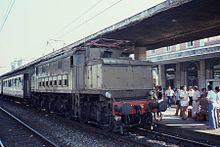
One of the first electric locomotives used before the Simplon-Orient-Express was the FS E 626 series.
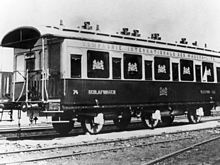
1883 in the Orient-Express used three-axle sleeping car, CIWL-No. 74

CIWL sleeping car 151, built by Rathgeber in 1883
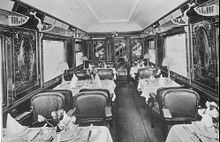
Dining room of a CIWL dining car, before 1900
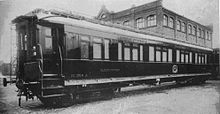
CIWL sleeping car 1764A, delivered by MAN in 1908
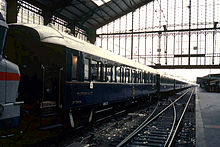
Sleeping car type Lx
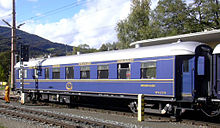
1944 built CIWL dining car

Bavarian S 3/6s became famous for their service in front of the Rheingold, but they also crewed the Orient-Express

The film train locomotive of the Orient-Express PO 4353 (SNCF 230 G 353) in 2014 as an exhibit in front of the IMA
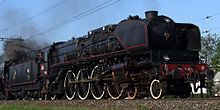
Among the largest locomotives used before the Simplon-Orient-Express was the 241A of the French Eastern Railway
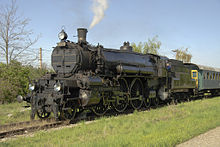
For several decades, locomotives of the series 310 were used by KkStB or BBÖ in front of the Orient Express, as series 375.0 also by the ČSD
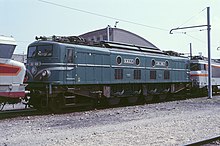
The class 9100 locomotives crewed the Simplon-Orient-Express and the Direct-Orient from the early 1950s on the electrified French sections until the last run on 19 May 1977.
Tourist trains
Even before the end of the through Orient Express to Istanbul, private entrepreneurs began restoring old CIWL carriages and using them for charter trips on rails. Since 1976, various companies have been using the resulting nostalgic train sets for rail cruises. They all have names derived from the Orient Express, but these do not correspond to the historical names of the scheduled trains.
Luxury trains used for rail cruises on other continents are also often referred to by the epithet "Orient Express", sometimes in a slightly modified form. Examples are the American Orient Express used in the USA, the Eastern and Oriental Express running between Bangkok and Singapore in Southeast Asia or the Indian Royal Orient Express.
Nostalgia Istanbul Orient Express
The first provider of this type of rail cruise was the Swiss entrepreneur Albert Glatt, owner of Intraflug AG. He collected original CIWL cars from the 1920s and 1930s since the early 1970s and had them restored to their 1926-29 delivery condition. The Nostalgia Istanbul Orient Express (NIOE) was the first luxury train of this kind and ran from the beginning of 1976 until mid-2008. Only restored original CIWL vehicles were used. Various routes across Europe were offered.
The NIOE cars made their longest trip in September 1988, when they traveled from Paris across Europe via Berlin, Warsaw, Moscow, and the Trans-Siberian Railroad to Hong Kong on the occasion of the anniversary of a Japanese television station. Brought to Japan by ship, they were converted to cape gauge there and used for various trips.
In 1993, the Mittelthurgau travel agency took over the NIOE cars and used them together with five observation cars from the TEE Rheingold, two cars from the historic Rheingold luxury train of the Deutsche Reichsbahn in 1928, and the converted French state dining car No. 3354 (of French President Charles de Gaulle). Likewise, an SNCF dining car L'Aquitaine was restored in a nostalgic style.
Thirteen NIOE cars were rebuilt for the Russian broad gauge on their own bogies and ran on the Russian broad gauge network, including on the Trans-Siberian Railway until October 2007. At the beginning of 2008, the NIOE, train part Russian traffic, returned from the Moscow depot to Europe and was deposited securely with PKP.
After the insolvency and bankruptcy of the Mittelthurgau travel agency and the Mittelthurgaubahn in 2001, the Transeurop Eisenbahn AG (TEAG) in Basel took over the entire NIOE and its more than 30 former CIWL cars built between 1926 and 1929. At an expense of millions, the cars were completely refurbished from 2003 to 2005. The company Orient-Express Train de Luxe Betriebs GmbH / Austria managed the railway operation and sale. Today, the NIOE wagon fleet of TEAG and two subsidiaries comprises 32 former CIWL wagons. Also in the inventory are former saloon cars of the NS Reich government as well as six old Rheingold cars from 1928, two of which have been completely refurbished.
As a result of a legal trademark dispute brought by the operating company of the Venice Simplon Orient Express (VSOE) and conducted with SNCF concerning the original brand name Orient-Express, the operation of the NIOE had to be suspended in 2007. In 2008, an international court was to rule on the lawsuit and a counterclaim that had been filed in the meantime. The case has since been accepted by the European Court of Justice, but no decision has yet been made. A decision date is completely open. Since July 2008, therefore, the business and driving operations of the NIOE have been suspended, and the CIWL cars have been stored in preserved condition. In autumn 2008, the cars were sold to an American railway company. This company operates the train as Grand Express European - Train de Luxe.
In 1988 a trip was made from Paris to Hong Kong. Thirteen carriages of the historic train used for this were hired out to the Russian company Orient-Express, which organised charter trips starting in Vladivostok and in Beijing over a period of twelve years. When the rental contract expired in 2008, the wagons were to be returned to their owner in Austria, but the owner was not prepared to pay fees for the storage of the standard gauge bogies in Belarus. As a result, the wagons were stored on a wide gauge siding in the Polish marshalling yard Małaszewicze near the border with Belarus, whereby PKP also demanded fees for the use of the siding. Conversely, the owner demanded that PKP Cargo pay for the damage caused by vandalism. In the end, the wagons were taken over by SNCF and transported away in January 2019 without bogies.
Venice Simplon-Orient-Express
→ Main article: Venice Simplon-Orient-Express
In 1977 Sea Containers Ltd. began to acquire and extensively restore historic wagons, which were used for the first time in 1982 as the Venice Simplon-Orient-Express (VSOE). The first trip offered was the route of the former Simplon-Orient-Express from London to Venice and once a year to Istanbul. In the UK, the Belmond British Pullman operates daytime services as a feeder, with passengers travelling in the ship across the English Channel and continuing on the continent by VSOE. In addition to running on the route of the former Simplon-Orient-Express, the VSOE also runs to other cities in Europe. The historic carriages were modernised in the 2000s and fitted with new bogies, enabling them to travel at 160 km/h.
Pullman Orient Express
CIWL first briefly pursued plans for a rail cruise with its blue sleeping cars on the historic Orient Express route between Paris and Istanbul in 1967, but ultimately did not realize it. Following the success of NIOE and VSOE, CIWL did not enter the nostalgia cruise business until 1994. Initially, it used seven and later nine of its historic dining and Pullman cars built between 1920 and 1939, mainly for day trips on domestic services in France, or hired them out to tour groups. In contrast to the NIOE and VSOE, however, the CIWL usually did not use sleeping cars in these trains; if necessary, normal sleeping cars from the SNCF stock were used.
Since 2007, the Pullman Orient Express has also been dormant due to the trademark dispute over the name Orient-Express. The Accorgroup as owner of the CIWL decided to stop the operation, because it was attacked by SNCF and VSOE under trademark law. The wagons have not been used since and were to go into a museum if necessary. Recommissioning was out of the question, according to the board decision. The train was taken over by the SNCF in 2008 and has since been marketed as the Orient Express by the Société des Trains Expos (STE) branch.
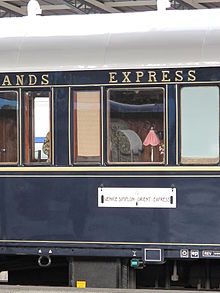
Car with VSOE train sign
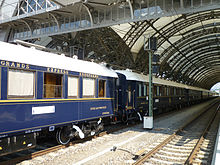
Type Lx sleeping car in Dresden Hbf, modernised with modern bogies for the VSOE
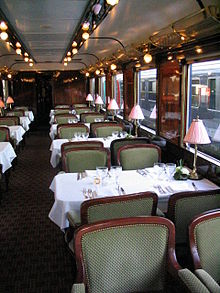
View into a dining car of the Pullman Orient Express
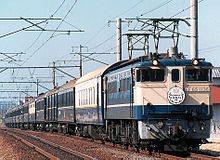
The NIOE 1988 in Japan
Search within the encyclopedia